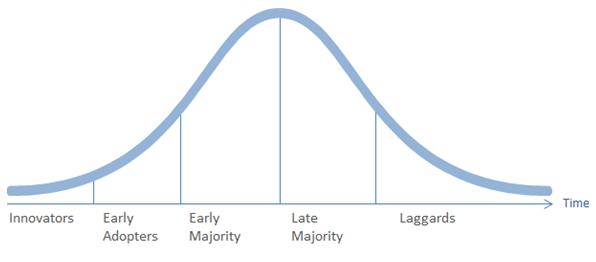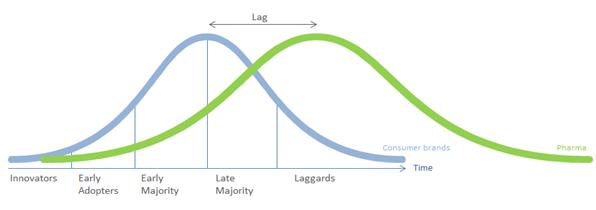Pharma gets social: diffusion of pharma social media innovators

Daniel Ghinn
Creation Healthcare
In his latest ‘pharma gets social’ piece, Daniel Ghinn discusses the Diffusion of Innovators model, comparing it to his own model called the Diffusion of Pharma Digital Innovators.
(Continued from “Pharma gets social: what will Boehringer Ingelheim’s Syrum game achieve?”)
When I founded Creation Healthcare back in 1998, in the same year that doctors.net.uk launched as an email service for doctors in the UK, it was clear to me that the Internet was about to change everything. We had no idea back then that social media channels would explode in the years to come, or the role smartphones would play in keeping us always online, connected via apps and the mobile web. But we were already seeing innovators use Internet technologies to do things better.
Since mid 2011, this series, pharma gets social, has reviewed examples of pharmaceutical companies using social media. I have celebrated Lilly’s use of social media in clinical trial recruitment, Bayer’s early adoption of Pinterest, and Boehringer Ingelheim’s innovation in social gaming.
This week, I am preparing for the launch of Creation Healthcare’s fourth annual Healthcare Engagement Strategy Awards, our round-up of the world’s most effective healthcare engagement strategies. Already, 2012 has been an outstanding year in this field and I suspect that pharmaceutical social media strategies will feature highly among the year’s winners.
 ,
"We had no idea back then that social media channels would explode in the years to come..."
 ,
Yet these concepts would hardly be worthy of comment today outside of the pharmaceutical industry. What on earth makes the subject of pharma in social media worthy of a dedicated monthly column?
Diffusion of Innovators
The Diffusion of Innovators is a familiar concept, conceived by Professor Everett Rogers in the 1960s. And it is as relevant as ever in the context of social media innovation. As time passes, new channels are adopted by ‘innovators’ – a small group who may face ridicule or at least doubt among peers, before ‘early adopters’ come on board and adoption accelerates, taking in early and late majority groups, and finally laggards. The whole process can take anything from weeks to years.
Figure 1: Diffusion of Innovators (Rogers, 1962)
Applying this model to the successful adoption of social media channels, we see pharmaceutical companies lagging behind mainstream consumer companies. In fact, when it comes to social media and emerging channels, I have observed a separate, delayed diffusion curve for pharmaceutical companies – let’s call it the Diffusion of Pharma Digital Innovators.
Figure 2: Diffusion of Pharma Digital Innovators
In this model, a particular digital channel at the late majority stage for mainstream consumer brands might only be at the early adopters stage for the pharmaceutical industry. Consider Facebook as an engagement platform, for example. While mainstream consumer brands might be considered at least in the late majority stage, I would suggest that the pharmaceutical industry is emerging from the early adopters to the early majority stage. The difference between the curves may be considered the ‘Pharma Digital Innovation Lag’, a delay of arguably somewhere between 1-2 years.
 ,
"Applying this model to the successful adoption of social media channels, we see pharmaceutical companies lagging behind mainstream consumer companies."
 ,
The primary effects of this lag as I observe it are:
• Digital innovators in pharma who are unaware of the lag become highly frustrated, while those who see the lag in operation have hope.
• Successful pharma innovators learn and apply lessons from brands on the mainstream innovation curve.
• Pharma typically benefits from innovating in digital environments that are more mature and widely adopted by its stakeholders, than brands on the mainstream innovation curve.
What does the future hold?
Awareness of this lag in operation means the pharmaceutical industry can and does look at digital trends affecting consumer brands with an expectancy that many of them will be successfully adopted by the industry in time to come. Among these trends are an increase in the integration of social, mobile and location based technologies that are gaining traction in the consumer world.
Changes taking place among stakeholder behaviour include a significant move by healthcare professionals into public social media channels like Twitter and open forums to discuss clinical and practice matters. This trend was unimaginable some years ago, yet today is opening up new doors of engagement for the most forward-thinking pharmaceutical companies.
 ,
"This trend was unimaginable some years ago, yet today is opening up new doors of engagement for the most forward-thinking pharmaceutical companies."
 ,
Of course, the pharmaceutical industry faces its own set of challenges that are not present among the innovators of the consumer world. Heavy regulation makes two-way social engagement more complex, and traditional business models are being challenged by stakeholders’ own adoption of digital channels.
The road will still be challenging for pharma’s pioneers of social media and other emerging channels, yet it is these innovators who will continue to ensure the industry’s effective engagement with stakeholders in the changing digital age.
 ,
 ,
About the author:
Daniel Ghinn is CEO at Creation Healthcare, the research and training consultancy to the pharmaceutical and healthcare industry. He can be reached at by Twitter at @EngagementStrat or by email daniel.ghinn@creationhealthcare.com.
How can pharma avoid the ‘Digital Innovation Lag’?













